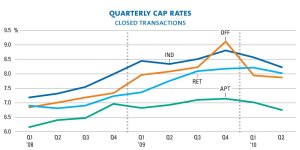 Real Capital Analytics reported last week that national multifamily and commercial real estate sales spiked in June, rising to $9.7 billion in the month. This was the highest volume of significant commercial property sales since September 2008. The latest closings pushed sales for the first half of 2010 to $36.2 billion, up 67 percent from the cyclical low during the same period one year earlier.
Real Capital Analytics reported last week that national multifamily and commercial real estate sales spiked in June, rising to $9.7 billion in the month. This was the highest volume of significant commercial property sales since September 2008. The latest closings pushed sales for the first half of 2010 to $36.2 billion, up 67 percent from the cyclical low during the same period one year earlier.
The increase in activity-over the year, from the first to the second quarter and over the second quarter itself-suggests that investors remain largely undeterred by downward revisions to the economic outlook and shots across stability’s bow from Europe’s debt markets. The current tally of properties in contract suggests that prevailing levels of activity will be sustained into the third quarter.
The rise in sales coincides with tentative improvements in national pricing trends as well. The Moody’s/REAL Commercial Property Price Index, based on repeat sales data from Real Capital, shows a 3.6 percent increase in its all-property-types index for May. Like headline measures of transaction volume, prices have come off their lows, rising by 8.6 percent since their nadir in October 2009. Across the sectors and for all transactions, cap rates were consistently lower at midyear as compared to late-2009 highs. In the office sector, in particular, average cap rates for closed sales in June were just below 8 percent, almost 100 basis points lower than in January.
While dominating the national statistics, the decline in cap rates and improvement in sales volume remain concentrated in markets historically of greatest appeal to large institutional and foreign investors. This concentration complicates the interpretation of headline trends across which the broad swath of national activity is aggregated. Between the first and second quarters, the largest cap rate declines have been in top-tier markets where high-quality assets continue to command investor attention and resulting price premiums.
The limited supply of high-quality assets available for sale has been a feature of the “nothing to buy” marketplace. Washington, D.C., for example, reported an average office cap rate of 6.4 percent for the first half of 2010. Just north of the nation’s capital, however, the Baltimore metro area reported an average office cap rate of 9 percent. Here in New York City, a handful of large Manhattan office assets have closed or are in contract, feeding a marketplace eager for pricing benchmarks that can facilitate additional transactions.
THE IMPROVEMENTS IN the sector’s headline measures have prompted some market observers to announce the bottom in pricing and fundamentals, and an early-stage recovery for commercial real estate. Seven months ago, a Jan. 18 Time magazine story was headlined “A Slow-Motion Wreck for Commercial Real Estate.” But last week, Time offered a fresh, rhetorical inquiry: “Is Commercial Real Estate Bouncing Back?”
To be sure, transaction activity and investment flow have come off their lows, but it remains unclear if the same can be said for the sector’s other measurable outcomes.
The ponderings of the editors at Time and elsewhere reflect a positive shift in mood in the multifamily and commercial real estate sector, but one that contrasts with the prevailing decline in consumer and general business sentiment. On one hand, commercial real estate investors’ spirits have been buoyed by the coincidence of some recent improvements in net absorption, the initial easing of credit markets, and the acceleration of price discovery from higher transaction counts. Interest rates remain exceptionally low for qualifying borrowers; and fear of tax code changes may be motivating some sellers to enter the market earlier. While closed and in-contract sales are up, so are offerings. The numbers augur well for volume in the second half for 2010.
But drivers of optimism belie another, broader trend that has been characterized by volatility in stock markets; concerns-whether well founded or unfounded-of a double-dip recession; and a sharp drop in consumer confidence. By the Conference Board’s measure, consumers’ assessments of both current and prospective business and job market conditions dropped during June. Fewer than one in six consumers believe that job openings will increase over the next six months.
Consumers’ circumspection is reflected in weaker measures for the general economic outlook. In recent weeks, the Fed has been among the key centers of thought to ratchet back projections for domestic growth. Market observers who make pronouncements about continued improvements in net absorption but who also sound off on their dour long-term labor market outlook will have to concede the contradiction.
A strong recovery in business profitability and businesses’ hiring are cornerstones of strong fundamentals. Anytime prices and cash flow decouple, the need for prudence rises. Pricing can sometimes lead fundamentals gains, but the gains must ultimately materialize for pricing momentum to be sustained.
And so investors’ current optimism-in bidding on assets in the nation’s top-tier metros or in anticipating a rise in occupancy-must be qualified. In fact, digging into recent transactions reveals that investors are weighing these considerations: As just one example, the occupancy rate for recent Manhattan property sales has invariably exceeded the market-wide measures of space performance.
Buyers and sellers coming together to negotiate for lower-quality portfolios will have to wait a while longer for fundamentals to drive prices.
schandan@rcanalytics.com
Sam Chandan, Ph.D., is global chief economist and executive vice president of Real Capital Analytics and an adjunct professor of real estate at Wharton.


